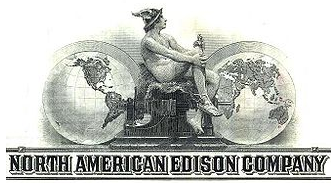
A ticker symbol or stock symbol is an abbreviation used to uniquely identify publicly traded shares of a particular stock on a particular stock market. In short, ticker symbols are arrangements of symbols or characters representing specific assets or securities listed on a stock exchange or traded publicly. A stock symbol may consist of letters, numbers, or a combination of both. "Ticker symbol" refers to the symbols that were printed on the ticker tape of a ticker tape machine.
Northern States Power Company (NYSE: NSP) was a publicly traded S&P 500 electric and natural gas utility holding company based in Minneapolis, Minnesota, that is now a subsidiary of Xcel Energy.

Exelon Corporation is a public utility headquartered in Chicago, Illinois, and incorporated in Pennsylvania. Exelon is the largest electric parent company in the United States by revenue and is the largest regulated electric utility in the United States with approximately 10 million customers. The company is ranked 99th on the Fortune 500.

FirstEnergy Corp is an electric utility headquartered in Akron, Ohio. It was established when Ohio Edison merged with Centerior Energy in 1997. Its subsidiaries and affiliates are involved in the distribution, transmission, and generation of electricity, as well as energy management and other energy-related services. Its ten electric utility operating companies comprise one of the United States' largest investor-owned utilities, based on serving 6 million customers within a 65,000-square-mile (170,000 km2) area of Ohio, Pennsylvania, West Virginia, Virginia, Maryland, New Jersey, and New York. Its generation subsidiaries control more than 16,000 megawatts of capacity, and its distribution lines span over 194,000 miles. In 2018, FirstEnergy ranked 219 on the Fortune 500 list of the largest public corporations in the United States by revenue.
The Dow Jones Composite Average is the stock market index composed of 65 prominent companies traded on both exchanges, maintained and tracked by S&P Dow Jones Indices. The average's components include every stock from the Dow Jones Industrial Average, the Dow Jones Transportation Average (20), and the Dow Jones Utility Average (15).

DTE Energy is a Detroit-based diversified energy company involved in the development and management of energy-related businesses and services in the United States and Canada. Its operating units include an electric utility serving 2.2 million customers and a natural gas utility serving 1.3 million customers in Michigan.
DTE Electric Company was founded in 1886.

Arizona Public Service (APS) is the largest electric utility in Arizona, United States. Since 1985, it has been the principal subsidiary of publicly traded S&P 500 member Pinnacle West Capital Corporation, known as AZP Group until 1987. Pinnacle West Capital made a profit of $500 million in 2017.

Vectren Corporation was a Fortune 1000 energy holding company headquartered in Evansville, Indiana. Through its utility subsidiaries, the company distributed natural gas to approximately one million business and residential customers in Indiana and Ohio. It also distributed electricity to 141,000 customers and had 1,425 MW of primarily coal-fired generating capacity in Indiana. Vectren's nonutility subsidiaries and affiliates offered energy-related products and services to customers throughout the Midwest and Southeast. These included energy performance services and energy infrastructure services.

Ameren Corporation is an American power company created December 31, 1997, by the merger of St. Louis, Missouri's Union Electric Company and the neighboring Central Illinois Public Service Company of Springfield, Illinois. It is now a holding company for several power companies and energy companies. The company is based in St. Louis, serving 2.4 million electric, and 900,000 natural gas customers across 64,000 square miles in central and eastern Missouri and the southern four-fifths of Illinois by area.
The Union Electric Company of Missouri was an electric power utility that was organized in 1902 and grew to be one of the large U.S. companies listed among the S&P 500. In 1997, its holding company merged with a smaller neighboring utility, Central Illinois Public Service Company through its holding company, CIPSCO Inc., to form Ameren Corporation based in St. Louis, Missouri.
The Central Illinois Public Service Company was an electric streetcar holding company and power utility first organized in 1902. Under its later quarter billion dollar holding company, CIPSCO Inc., it merged in 1997 with the larger neighboring Union Electric Company of Missouri to form Ameren Corporation based in St. Louis, Missouri. Now a subsidiary, Ameren Illinois is headquartered in Springfield, Illinois.

WEC Energy Group is an American company based in Milwaukee, Wisconsin that provides electricity and natural gas to 4.4 million customers across four states.
MDU Resources Group, Inc. is a U.S.-based corporation supplying products and services to regulated energy delivery and utilities related construction materials and services businesses. It is headquartered in Bismarck, North Dakota, and operates in 48 states.
This is a list of Electricity distribution companies by country.

Spire Inc. is a regional public utility holding company based in St. Louis, Missouri, providing natural gas service through its regulated core utility operations while engaging in non-regulated activities that provide business opportunities. Its primary subsidiary Laclede Gas Company is the largest natural gas distribution utility in Missouri, serving approximately 631,000 residential, commercial and industrial customers in the City of St. Louis and ten counties in eastern Missouri. Its corporate headquarters is located in the 700 Market building in downtown St. Louis.
Algonquin Power & Utilities Corp. is a Canadian renewable energy and regulated utility conglomerate with assets across North America. Algonquin actively invests in hydroelectric, wind and solar power facilities, and utility businesses, through its three operating subsidiaries: Bermuda Electric Light Company, Liberty Power and Liberty Utilities.
MGE Energy: MGE Energy, Inc. is a utility holding company based in Madison, Wisconsin. Its main subsidiary, Madison Gas and Electric Co., produces and distributes electricity and distributes natural gas.











